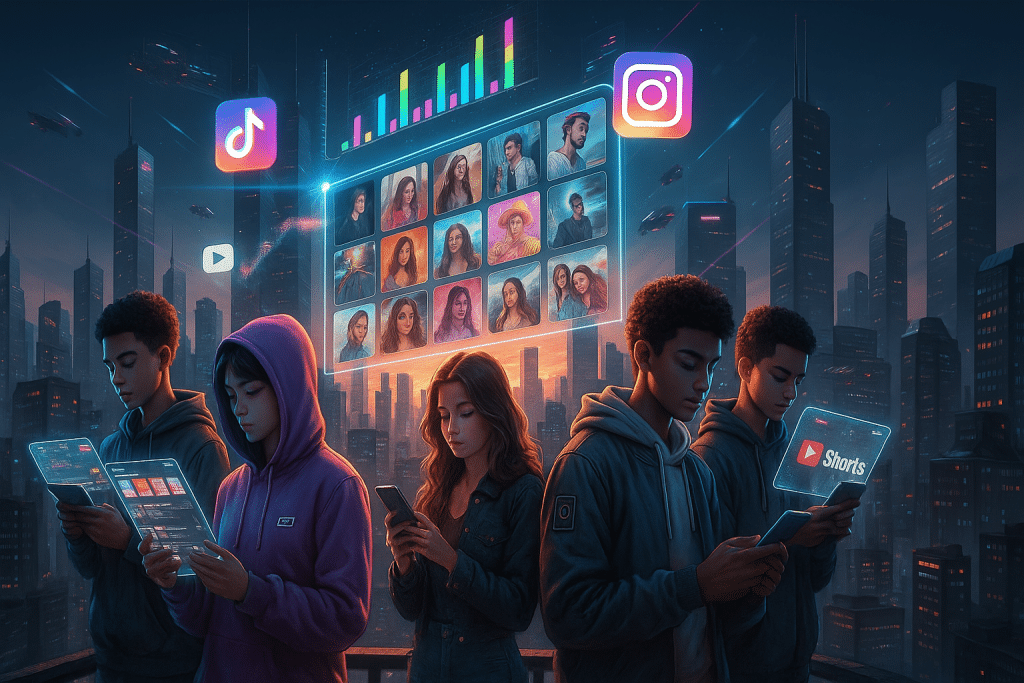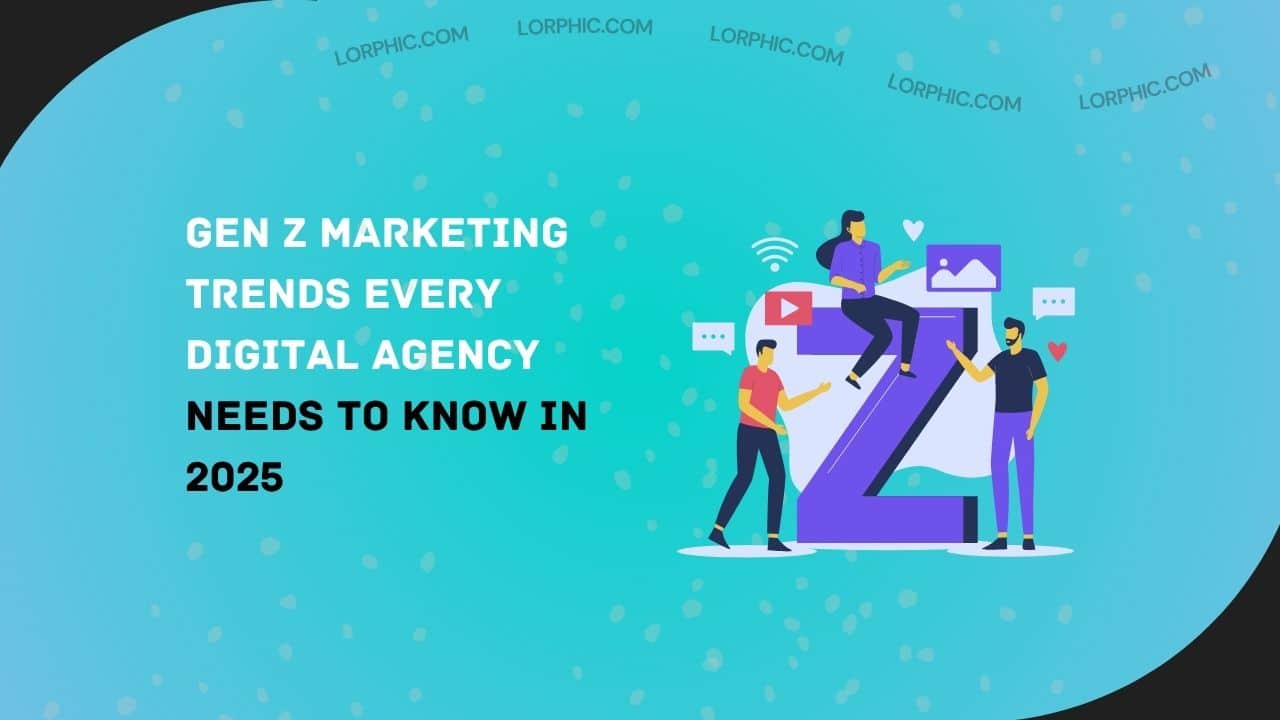Generation Z Overview
Generation Z, broadly defined by the Pew Research Center as those born from 1997 to 2012, is an influential cohort currently aged approximately 13 to 28. Having grown up immersed in the digital landscape of Web 2.0, mobile connectivity, and social media, they are the first true Digital Natives. Their collective identity is shaped by a complex mix of economic uncertainty, a post-2008 financial crisis worldview, and the global ubiquity of information, which fosters a distinct set of consumer expectations.
For digital agencies, understanding Gen Z and gen z marketing is not just about adopting a new social media platform; it is about fundamentally re-evaluating the principles of brand communication, value proposition, and customer engagement. As Gen Z’s oldest members fully enter the workforce and their collective global income is projected to reach $36 trillion by 2030 (Kasasa), their immediate and future purchasing power makes them a critical target demographic.
This comprehensive guide details the essential trends, concepts, methods, and challenges digital agencies must master to effectively connect with, market to, and build lasting loyalty with Generation Z consumers.

Overview: The Gen Z Digital Identity
Generation Z’s relationship with technology, information, and commerce is characterized by four core traits that upend traditional marketing models:
- Constant connectivity
- Information skepticism
- A demand for authenticity
- Values-driven purchasing
This generation treats the internet and social media less as a tool and more as a foundational layer of reality. Their media consumption is highly fragmented, highly visual, and increasingly focused on user-generated content (UGC).
Distinctive Media Consumption Habits
Social-First Video Consumption
For Gen Z, the line between social media and television is heavily blurred. A 2025 Deloitte study found that nearly 60% of Gen Z spend more time watching social media videos than streaming services, viewing social content as a primary form of “watching TV.”
The Attention Span Challenge
In a hyper-saturated content environment, Gen Z’s attention span for traditional digital advertisements is notoriously short, reportedly averaging just 1.3 seconds for an ad, underscoring the necessity for instantly engaging, high-value, and platform-native content.
Platform Fragmentation
While their usage is high across the board, they actively differentiate between platforms. YouTube and TikTok are dominant for content discovery, with TikTok users finding something new on the platform every month. They are also increasingly utilizing community-centric sites like Reddit for niche, algorithm-fatigued discussion, and platforms like Snapchat for direct, authentic communication with friends.
Key Concepts: Redefining Value and Trust
Successful Gen Z marketing hinges on understanding the non-negotiable values this generation applies to its consumer decisions. Agencies must shift their focus from what a brand sells to what a brand stands for and how it communicates its story.
1. Radical Authenticity and Relatability
Gen Z values content that is raw, honest, and relatable over high-gloss, overly polished production. They are highly attuned to inauthentic brand posturing.
Creator Connection: Over half of Gen Z respondents in a Deloitte survey reported feeling a stronger connection to independent creators than to traditional TV actors. This preference is driven by the perceived honesty and relatability of the creator’s voice, which contrasts sharply with the calculated nature of celebrity endorsements.
UGC as Social Proof: User-Generated Content (UGC) is a critical form of social proof. Gen Z relies heavily on peer validation, such as authentic reviews and unscripted creator content, when making purchasing decisions, particularly in areas like travel and e-commerce.
2. Values-Driven Commerce and Social Justice
Gen Z is the most racially and ethnically diverse generation in the US and globally. Their consumption patterns are often a reflection of their personal values, which heavily include diversity, inclusivity, and environmental responsibility.
Sustainability as Standard: Ethical and sustainable brand practices are increasingly viewed as the baseline expectation, not a premium offering. A 2025 Deloitte survey indicated that 65% of Gen Z are willing to pay more for products or services from sustainable and eco-friendly companies.
Corporate Responsibility: They support brands that take public stances on social and political issues, especially those related to social justice and the environment. Conversely, they are quick to call out (or “cancel”) brands whose actions contradict their stated values.
Tools, Methods, or Techniques for Engagement
To effectively implement the principles of authenticity and values, digital agencies must leverage a specific set of tools and techniques that are native to Gen Z’s digital spaces.
Method 1: The Short-Form Video (SFV) and Vertical Content Strategy
The dominance of TikTok, Instagram Reels, and YouTube Shorts makes SFV the single most important content format. Agencies must pivot from repurposing long-form assets to creating native vertical video designed to capture attention in milliseconds.
| Element | Description | Actionable Agency Tactic |
|---|---|---|
| Hook | Must capture attention within the first 1-2 seconds to beat the 1.3-second attention barrier. | Use text overlays, fast cuts, trending sounds, or immediate, provocative questions. |
| Trendjacking | Participating in viral cultural moments, meme formats, or sound challenges. | Establish a dedicated “trend-spotting” team for real-time content creation, not delayed planning. |
| Storytelling | Content should feel like a peer-to-peer conversation or a micro-narrative, not an advertisement. | Focus on product tutorials, “day-in-the-life” content, or vulnerability/behind-the-scenes looks. |
| Format | Vertical video (9:16 aspect ratio) is preferred, reflecting Gen Z’s mobile-first viewing habits, with 42% preferring this format for even longer micro-series. | Prioritize mobile-first production and testing for all video content. |
Method 2: Nano- and Micro-Influencer Marketing (The Trust Model)
While budgets for celebrity-driven campaigns are still allocated, Gen Z’s rising skepticism toward high-volume sponsored content has made smaller-scale creators the most potent sources of influence.
Niche Expertise: Nano-influencers (1k–10k followers) and Micro-influencers (10k–100k followers) typically specialize in a very narrow niche, fostering deep, community-level trust. This depth of connection results in higher engagement: In 2024, nano-influencers on TikTok achieved engagement rates of 10.3%, significantly higher than the 7.1% seen by macro-influencers.
Product Seeding: A highly effective, authentic strategy is product seeding: sending free product to creators without a formal contractual obligation to post. This cultivates genuine advocacy and organic reviews, which Gen Z finds far more credible than overtly sponsored posts. Agencies must manage and scale these seeding programs to leverage this grassroots growth.
Current Trends, Statistics, & Research Findings
Data from leading industry studies reveals a clear picture of Gen Z’s digital journey and consumer funnel, highlighting where agencies need to allocate resources.
The New Purchase Journey: Discovery to Conversion
The traditional search-engine-to-e-commerce-site purchase model is breaking down, especially for inspiration and product discovery.
Discovery on Social: 77% of Gen Z users discover new products on TikTok, demonstrating its role as a key discovery engine, surpassing traditional search for initial awareness.
The Travel Shift: For travel, a sector with high aspirational value for this generation, a major shift is evident: 50% of Gen Z start their travel search on social media, a stark contrast to older generations who default to search engines or aggregator sites.
The Final Friction Point: Gen Z is more likely to abandon a purchase due to checkout friction. Unlike older consumers who abandon because they aren’t ready to buy, Gen Z’s top reason for cart abandonment is that their chosen payment method is not accepted or the checkout process has too many steps.
| Platform | Primary Gen Z Use Case | Key Statistics |
|---|---|---|
| TikTok | Product Discovery, Entertainment, Trend Culture | 77% discover products here; 91% find something new monthly. |
| YouTube | Long-form Deep Dive, Entertainment, Tutorials | Accounts for the largest number of Gen Z viewers (approx. 63.9 million in the US). |
| Lifestyle, Visual Inspiration, Micro-Communities | Ranks among the top 3 used platforms for Gen Z, alongside YouTube and TikTok. | |
| Snapchat | Direct Communication, AR Filters, Peer-to-Peer Interaction | Makes up 52.3% of its user base, and Sponsored Snaps drive higher conversions than full-screen ads. |
The Power of Fandom and Community
Gen Z actively seeks out and creates community, often centering their sense of belonging around shared interests (fandoms) rather than traditional institutions. This presents a unique marketing opportunity:
- Co-Creation and Belonging: A 2025 Deloitte report noted that 50% of Gen Z say being part of a community is important, and they view fandom as a way to make new friends.
- Shifting from Broadcasting to Co-Creation: Agencies must move from a one-way communication model (broadcasting) to a two-way engagement model (co-creation), involving Gen Z in product design, content narrative, and brand identity through feedback loops, UGC challenges, and online micro-communities.
Challenges or Considerations
Marketing to Gen Z is fraught with unique challenges that can derail campaigns if not carefully navigated. Agencies must be vigilant about ethical concerns and digital fatigue.
1. Navigating Digital Fatigue and Mental Wellness
While digitally connected, Gen Z experiences significant digital fatigue and has a complex relationship with the mental health implications of social media.
- Conscious Disconnection: 83% of Gen Z have attempted to limit their social media use at some point. This indicates a growing desire for digital boundaries and a preference for real-life interactions.
- The ‘Perfection’ Backlash: Brands must avoid contributing to the culture of impossible digital perfection. Campaigns that promote mental wellness, self-acceptance, and healthy use of digital tools are more likely to resonate. Agencies should prioritize inclusive casting and realistic portrayals over idealized brand imagery.
2. The Algorithmic Anti-Marketing Push
Gen Z is growing increasingly aware of and skeptical toward manipulative or opaque algorithms that control their content feeds. This has led to a counter-movement.
- Search and Niche Platforms: The rise in usage of platforms like Reddit, which prioritizes community-centric, niche discussion over algorithmically curated entertainment, reflects a desire to circumvent the “mainstream” algorithm.
- SEO on Social: Agencies must optimize content not just for traditional Google Search Engine Optimization (SEO), but for “Social SEO” ensuring brand content is discoverable when Gen Z uses a platform’s internal search function (e.g., searching for product reviews on TikTok rather than Google).
3. Data Privacy and Transparency
Having witnessed numerous data breaches and privacy scandals, Gen Z is more aware of the data-for-service exchange than previous generations.
- Personalization vs. Privacy: While they expect personalized experiences (71% expect personalized interactions per McKinsey), they also demand transparency about how their data is collected and used. Agencies must ensure all targeting strategies are fully compliant and that their brand clients communicate data policies clearly and concisely, avoiding dense, unreadable legal text.
Conclusion & Key Takeaways
The digital landscape is being permanently reshaped by Generation Z. Their ascent is not just an opportunity for increased revenue, but a mandate for fundamental change in how digital agencies operate. The era of generic, one-size-fits-all digital advertising is over.
Digital intelligence for Gen Z is measured by an agency’s ability to act less like a broadcaster and more like a trusted co-creator and community member. The key is to blend seamless, friction-free purchasing experiences with content that demonstrates genuine, human connection.
Actionable Insights for Every Digital Agency:
- Prioritize Vertical Video Budget: Reallocate significant advertising spend from traditional digital display and pre-roll formats to short-form vertical video designed specifically for TikTok and Reels, utilizing platform-native tools and trending sounds.
- Shift to the Trust Triangle: Move campaign emphasis from Celebrity Endorsers to Nano- and Micro-Influencers. Implement scaled product seeding programs to generate authentic, high-trust UGC and organic social proof.
- Integrate Values, Don’t Just Signal Them: Ensure the brand’s commitment to social and environmental responsibility is woven into the product, operations, and supply chain, not just its marketing copy. Authenticity requires consistency between brand promise and brand action.
- Optimize the Final Step: Ruthlessly simplify the e-commerce checkout process, minimizing steps and maximizing modern, digital payment options (Apple Pay, Google Pay, etc.) to combat Gen Z’s high cart abandonment rate at the point of friction.
Agencies that successfully adopt these trends will not just reach Gen Z, but will forge the loyal, community-driven relationships that define the future of digital commerce.
Curated by Lorphic
Digital intelligence. Clarity. Truth.




